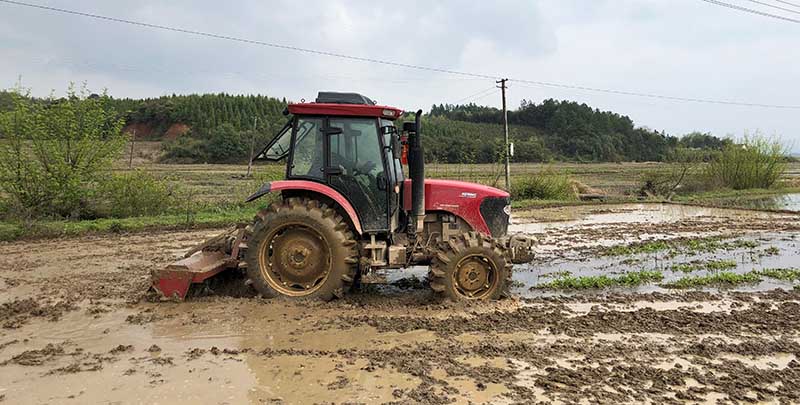Advantages of Farm tractors
Farm tractors have many significant advantages in modern agricultural production:
1. Powerful power output
- Farm tractor are usually equipped with powerful engines that can provide enough power to pull various agricultural implements. For example, the engine power of large tractors can reach 100-500 horsepower. This powerful power allows them to easily pull deep plows and tillage up to 30-50 cm deep on hard ground, which is very important for breaking the plow bottom layer and improving soil structure.
- In addition to traction operations, the power output shaft (PTO) can also provide power for rotary agricultural implements such as rotary tillers, seeders, harvesters, etc. Taking the seeder as an example, the tractor's power output shaft drives the seeding device and fertilizer device of the seeding machine through the transmission device to ensure that seeds and fertilizers can be evenly spread in the field.
2. Versatility
- The tractor can be equipped with a variety of agricultural implements to achieve a variety of agricultural operation functions. In the tillage stage, it can be mounted with agricultural implements such as plows, harrows, rotary tillers, etc. to complete operations such as plowing, crushing soil, and leveling the land. For example, a rotary tiller driven by a tractor can quickly break up the soil, making the soil particles small and uniform, creating good soil conditions for sowing.
- In the planting stage, the tractor can tow the seeder and transplanter to accurately sow or transplant according to a certain row spacing and plant spacing. Moreover, in the field management stage, it can also mount sprayers, weeders and other equipment to carry out pest control and weed removal. In the harvest season, the harvesting of crops is completed by cooperating with harvesters or mowers.
3. Improve labor efficiency
- Compared with traditional human and animal labor methods, tractors have greatly increased the speed of agricultural production. Taking arable land operations as an example, a medium-sized tractor equipped with a suitable plow can cultivate about 5-10 acres of land per hour, while manual use of traditional agricultural tools may only cultivate 1-2 acres of land a day.
- In terms of sowing, the seeder towed by the tractor can complete large-scale sowing tasks in a short time, and the sowing quality is higher, which can ensure that the seeds are evenly distributed and the depth is consistent.
This highly efficient operation method enables agricultural production to be completed in a shorter time, especially during the busy farming season, ensuring timely sowing and harvesting of crops and reducing losses caused by weather and other factors.
4. Strong adaptability
- Tractors can adapt to various terrains and soil conditions. Tractors can play a role in both large areas of cultivated land in plains and small terraces in hilly and mountainous areas. In plains, large tractors can give full play to their power advantages and carry out large-scale and efficient operations; while in hilly and mountainous areas, small tractors can shuttle between narrow terrace roads and irregular fields with their flexible maneuverability.
- For different soil types, such as clay, sandy soil, loam, etc., tractors can adapt by adjusting agricultural tools and operation methods. For example, in clay plots, the tractor's operating speed can be appropriately reduced and the plow's entry angle can be increased to smoothly carry out ploughing operations.
5. Precision agriculture applications
With the development of technology, many tractors have advanced precision agriculture functions. For example, tractors equipped with a global positioning system (GPS) and an automatic navigation system can achieve automatic driving. When working in the field, it can accurately drive along the preset route, and the error can be controlled within a few centimeters.
At the same time, the tractor can also be connected to sensors, variable fertilization and sowing systems and other equipment to achieve variable fertilization, sowing and irrigation based on information such as soil fertility and crop growth conditions, improve the utilization efficiency of agricultural resources, reduce waste, and increase the yield and quality of agricultural products.



